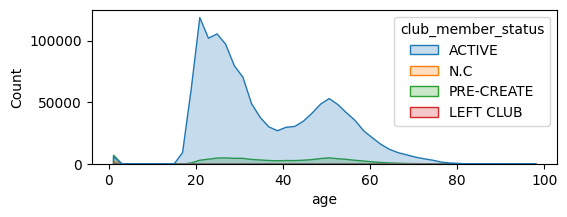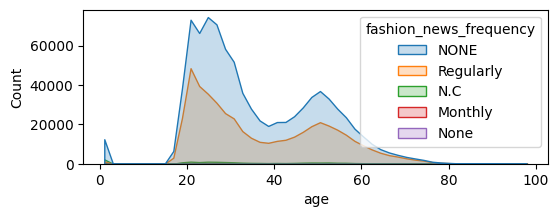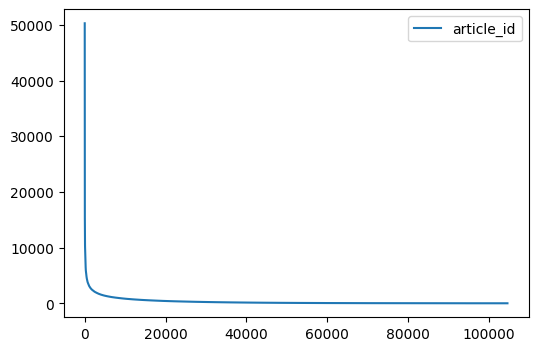H&M Personalized Fashion 1/2 - EDA
Banner made from a photo by Tembela Bohle on pexels
Introduction
H&M Group is a family of brands and businesses with 53 online markets and approximately 4,850 stores. The online store offers shoppers an extensive selection of products to browse through. But with too many choices, customers might not quickly find what interests them or what they are looking for, and ultimately, they might not make a purchase. To enhance the shopping experience, product recommendations are key. More importantly, helping customers make the right choices also has a positive implications for sustainability, as it reduces returns, and thereby minimizes emissions from transportation.
The goal of this data science challenge is to develop product recommendations based on data from previous transactions, as well as from customer and product meta data. The available meta data spans from simple data, such as garment type and customer age, to text data from product descriptions, to image data from garment images. Here we’re not going to use the images.
This project is divided in 2 parts:
- the first one (this notebook) is an EDA in order to gain insights from the available datasets, and to know how to prepare the dataset for the 2nd step
- in a second notebook: we’ll use the python library LightFM to build different recommendations models.
First insight
Let’s start by importing all the libraries we’re going to use, and load the three datasets relative to the customers, articles and transactions:
import numpy as np
import pandas as pd
import matplotlib.pyplot as plt
import seaborn as sns
import plotly.express as px
# plotly as pandas backend
# pd.options.plotting.backend = "plotly"
import os
from scipy import sparse
ENV = "COLAB" # "LOCAL" #
if ENV == "COLAB":
from google.colab import drive
drive.mount('/content/drive')
dir_path = "drive/MyDrive/recomm/projet/"
else:
dir_path = "../../../dataset/"
file_customers = "customers.csv"
file_articles = "articles.csv"
file_transactions = "transactions_train.csv"
df_customers = pd.read_csv(dir_path + file_customers)
df_articles = pd.read_csv(dir_path + file_articles)
df_transactions = pd.read_csv(dir_path + file_transactions)
Usually informations on the customers are more used for marketings (clustering / segmentation & KYC) purpose rather than for building the recommendation system. In order to get a big picture, we can start by a description of each datasets’ features (type, number & percentage of missing values, number & percentage of unique values and so on):
Metadata for each customer_id in dataset
def describe_df(df):
list_item = []
for col in df.columns:
list_item.append([
col,
df[col].dtype,
df[col].isna().sum(),
round(df[col].isna().sum()/len(df[col])*100, 2),
df[col].nunique(),
round(df[col].nunique()/len(df[col])*100, 2),
list(df[col].unique()[:5])
])
return pd.DataFrame(
columns=['feature', 'type', '# null', '% null', '# unique', '% unique', 'sample'],
data = list_item
)
assert df_customers.customer_id.nunique() == df_customers.shape[0]
describe_df(df_customers)
| feature | type | # null | % null | # unique | % unique | sample | |
|---|---|---|---|---|---|---|---|
| 0 | customer_id | object | 0 | 0.00 | 1371980 | 100.00 | [00000dbacae5abe5e23885899a1fa44253a17956c6d1c... |
| 1 | FN | float64 | 895050 | 65.24 | 1 | 0.00 | [nan, 1.0] |
| 2 | Active | float64 | 907576 | 66.15 | 1 | 0.00 | [nan, 1.0] |
| 3 | club_member_status | object | 6062 | 0.44 | 3 | 0.00 | [ACTIVE, nan, PRE-CREATE, LEFT CLUB] |
| 4 | fashion_news_frequency | object | 16009 | 1.17 | 4 | 0.00 | [NONE, Regularly, nan, Monthly, None] |
| 5 | age | float64 | 15861 | 1.16 | 84 | 0.01 | [49.0, 25.0, 24.0, 54.0, 52.0] |
| 6 | postal_code | object | 0 | 0.00 | 352899 | 25.72 | [52043ee2162cf5aa7ee79974281641c6f11a68d276429... |
Detailed metadata for each article_id available for purchase:
This database contains information about the assortiment of H&M shops.
Unique indentifier of an article:
article_id(int64) - an unique 9-digit identifier of the article, 105 542 unique values (as the length of the database)
5 product related columns:
product_code(int64) - 6-digit product code (the first 6 digits of article_id, 47 224 unique valuesprod_name(object) - name of a product, 45 875 unique valuesproduct_type_no(int64) - product type number, 131 unique valuesproduct_type_name(object) - name of a product type, equivalent of product_type_noproduct_group_name(object) - name of a product group, in total 19 groups
2 columns related to the pattern:
graphical_appearance_no(int64) - code of a pattern, 30 unique valuesgraphical_appearance_name(object) - name of a pattern, 30 unique values
2 columns related to the color:
colour_group_code(int64) - code of a color, 50 unique valuescolour_group_name(object) - name of a color, 50 unique values
4 columns related to perceived colour (general tone):
perceived_colour_value_id- perceived color id, 8 unique valuesperceived_colour_value_name- perceived color name, 8 unique valuesperceived_colour_master_id- perceived master color id, 20 unique valuesperceived_colour_master_name- perceived master color name, 20 unique values
2 columns related to the department:
department_no- department number, 299 unique valuesdepartment_name- department name, 299 unique values
4 columns related to the index, which is actually a top-level category:
index_code- index code, 10 unique valuesindex_name- index name, 10 unique valuesindex_group_no- index group code, 5 unique valuesindex_group_name- index group code, 5 unique values
2 columns related to the section:
section_no- section number, 56 unique valuessection_name- section name, 56 unique values
2 columns related to the garment group:
garment_group_n- section number, 56 unique valuesgarment_group_name- section name, 56 unique values
1 column with a detailed description of the article:
detail_desc- 43 404 unique values
assert df_articles.article_id.nunique() == df_articles.shape[0]
describe_df(df_articles)
| feature | type | # null | % null | # unique | % unique | sample | |
|---|---|---|---|---|---|---|---|
| 0 | article_id | int64 | 0 | 0.00 | 105542 | 100.00 | [108775015, 108775044, 108775051, 110065001, 1... |
| 1 | product_code | int64 | 0 | 0.00 | 47224 | 44.74 | [108775, 110065, 111565, 111586, 111593] |
| 2 | prod_name | object | 0 | 0.00 | 45875 | 43.47 | [Strap top, Strap top (1), OP T-shirt (Idro), ... |
| 3 | product_type_no | int64 | 0 | 0.00 | 132 | 0.13 | [253, 306, 304, 302, 273] |
| 4 | product_type_name | object | 0 | 0.00 | 131 | 0.12 | [Vest top, Bra, Underwear Tights, Socks, Leggi... |
| 5 | product_group_name | object | 0 | 0.00 | 19 | 0.02 | [Garment Upper body, Underwear, Socks & Tights... |
| 6 | graphical_appearance_no | int64 | 0 | 0.00 | 30 | 0.03 | [1010016, 1010017, 1010001, 1010010, 1010019] |
| 7 | graphical_appearance_name | object | 0 | 0.00 | 30 | 0.03 | [Solid, Stripe, All over pattern, Melange, Tra... |
| 8 | colour_group_code | int64 | 0 | 0.00 | 50 | 0.05 | [9, 10, 11, 12, 13] |
| 9 | colour_group_name | object | 0 | 0.00 | 50 | 0.05 | [Black, White, Off White, Light Beige, Beige] |
| 10 | perceived_colour_value_id | int64 | 0 | 0.00 | 8 | 0.01 | [4, 3, 1, 2, 5] |
| 11 | perceived_colour_value_name | object | 0 | 0.00 | 8 | 0.01 | [Dark, Light, Dusty Light, Medium Dusty, Bright] |
| 12 | perceived_colour_master_id | int64 | 0 | 0.00 | 20 | 0.02 | [5, 9, 11, 12, 2] |
| 13 | perceived_colour_master_name | object | 0 | 0.00 | 20 | 0.02 | [Black, White, Beige, Grey, Blue] |
| 14 | department_no | int64 | 0 | 0.00 | 299 | 0.28 | [1676, 1339, 3608, 6515, 1334] |
| 15 | department_name | object | 0 | 0.00 | 250 | 0.24 | [Jersey Basic, Clean Lingerie, Tights basic, B... |
| 16 | index_code | object | 0 | 0.00 | 10 | 0.01 | [A, B, G, F, C] |
| 17 | index_name | object | 0 | 0.00 | 10 | 0.01 | [Ladieswear, Lingeries/Tights, Baby Sizes 50-9... |
| 18 | index_group_no | int64 | 0 | 0.00 | 5 | 0.00 | [1, 4, 3, 26, 2] |
| 19 | index_group_name | object | 0 | 0.00 | 5 | 0.00 | [Ladieswear, Baby/Children, Menswear, Sport, D... |
| 20 | section_no | int64 | 0 | 0.00 | 57 | 0.05 | [16, 61, 62, 44, 26] |
| 21 | section_name | object | 0 | 0.00 | 56 | 0.05 | [Womens Everyday Basics, Womens Lingerie, Wome... |
| 22 | garment_group_no | int64 | 0 | 0.00 | 21 | 0.02 | [1002, 1017, 1021, 1005, 1019] |
| 23 | garment_group_name | object | 0 | 0.00 | 21 | 0.02 | [Jersey Basic, Under-, Nightwear, Socks and Ti... |
| 24 | detail_desc | object | 416 | 0.39 | 43404 | 41.12 | [Jersey top with narrow shoulder straps., Micr... |
the training data, consisting of the purchases each customer for each date, as well as additional information. Duplicate rows correspond to multiple purchases of the same item. Our task is to predict the article_id each customer will purchase :
df_transactions.t_dat = pd.to_datetime(df_transactions.t_dat, infer_datetime_format=True)
describe_df(df_transactions)
| feature | type | # null | % null | # unique | % unique | sample | |
|---|---|---|---|---|---|---|---|
| 0 | t_dat | datetime64[ns] | 0 | 0.0 | 734 | 0.00 | [2018-09-20T00:00:00.000000000, 2018-09-21T00:... |
| 1 | customer_id | object | 0 | 0.0 | 1362281 | 4.29 | [000058a12d5b43e67d225668fa1f8d618c13dc232df0c... |
| 2 | article_id | int64 | 0 | 0.0 | 104547 | 0.33 | [663713001, 541518023, 505221004, 685687003, 6... |
| 3 | price | float64 | 0 | 0.0 | 9857 | 0.03 | [0.0508305084745762, 0.0304915254237288, 0.015... |
| 4 | sales_channel_id | int64 | 0 | 0.0 | 2 | 0.00 | [2, 1] |
Focus on Customers
The metadata for each customer_id in the dataset consists of club member status, whether they subscribe to fashion news or not, and age. Some types are wrong due to missing values:
print(f"there are {(df_customers.age != df_customers.age.round()).sum()} customers whose age is not an integer")
print(f"there are {df_customers.age.isnull().sum()} ages missing")
there are 15861 customers whose age is not an integer
there are 15861 ages missing
Missing ages are arbitrarily replaced by 0 so that unknow values can be distinguished:
mapping = {"FN": 0, "Active": 1, "club_member_status": "N.C", "fashion_news_frequency": "N.C", "age": 0}
df_customers.fillna(value=mapping, inplace=True)
df_customers.drop(columns="postal_code", inplace=True)
for col in ["FN", "age", "Active"]:
df_customers[col] = df_customers[col].astype(np.int8)
Now let’s see the ratios of the number of customers for each feature:
cols = ["FN", "Active", "club_member_status", "fashion_news_frequency"]
fig, axes = plt.subplots(nrows=1, ncols=len(cols), figsize=(12, 6), tight_layout=True)
for i, c in enumerate(cols):
df_customers[c].value_counts().plot.pie(ax=axes[i], title=c)

cols = ["FN", "Active", "club_member_status", "fashion_news_frequency"]
fig, axes = plt.subplots(nrows=1, ncols=len(cols), figsize=(12, 3), tight_layout=True)
for i, c in enumerate(cols):
df_customers[c].value_counts().plot.bar(ax=axes[i], title=c)

By visualizing the distribution of the age, we can clearly see that:
- there are two types of clients: between 20 & 40, and older than 40 yrs old.
- the number of missing values isn’t too high
plt.figure(figsize=(6, 2))
sns.histplot(data=df_customers, x='age', bins=50)

The shape of the age distribution remains quite the same for each category of customer:
for c in cols:
plt.figure(figsize=(6, 2))
sns.histplot(data=df_customers, x='age', bins=50, hue=c, element="poly")
plt.show()




Focus on Articles
With a sunburst chart, we visualize the hierarchical structures of the different clothes’ categories:
- the “sport” category is the least represented
- while the “ladieswear” & the “baby/children” seem to be the most important
- unlike the “ladieswear” composed mostly of “Garment Upper Body”, the “baby/children” clothes are more diversified:
cols = ["index_group_name", "index_name", "product_group_name"]
df_temp = pd.DataFrame(df_articles[cols].value_counts()).rename(columns={0: "counts"}).reset_index()
px.sunburst(
df_temp,
path=cols,
values='counts',
)

If we don’t group those clothes by index_group by rather by product type, we can see that the most represented product are: dresses, sweaters, swim wear bodies & trousers:
def plot_bar(df, column):
long_df = pd.DataFrame(df.groupby(column)['article_id'].count().reset_index().rename({'article_id': 'count'}, axis=1))
fig = px.bar(long_df, x=column, y="count", color=column, title=f"bar plot for {column} ", width=900, height=550)
fig.show()
def plot_hist(df, column):
fig = px.histogram(df, x=column, nbins=10, title=f'{column} distribution ')
fig.show()
plot_bar(df_articles,'product_type_name')

plot_bar(df_articles,'product_group_name')

plot_bar(df_articles,'graphical_appearance_name')

Focus an Transactions
Most item catalogs exhibit the long tail effect (popularity bias): very few items are demanded & sold, whereas most of the articles aren’t sold that much.
df_transactions['article_id'].value_counts().reset_index().drop(columns=["index"]).plot(figsize=(6, 4))

Curiously, the same is also true for customers. This can be explained by the fact that few customers are in fact societies or resellers that buy high volumnes of items, where as the vast majority of the customers have only bought 1 or 2 items:
df_transactions['customer_id'].value_counts()\
.reset_index().sort_index().plot(figsize=(6, 4))

The history of transactions spans three years:
df_transactions["t_dat"].dt.year.unique()
array([2018, 2019, 2020])
Few spikes can be observed from the total daily sales, and can be explained by the shopping events or highly promoted sales at discounted price such as the “black friday”:
df_transactions['month'] = df_transactions["t_dat"].dt.month
df_transactions['year'] = df_transactions["t_dat"].dt.year
df_transactions['dow'] = df_transactions["t_dat"].dt.day_name()
df_temp = df_transactions.groupby('t_dat')['price'].agg(['sum', 'mean']).sort_values(by = 't_dat', ascending=False).reset_index()
px.line(df_temp, x='t_dat', y='sum', title='Total Sales daily', width=900, height=450).show()

The count of monthly sells shows that more items are sold during the summer (remember the swim wear body as most demanded):
df_temp = df_transactions.groupby(['year', 'month']).count()["article_id"].reset_index().rename(columns={"article_id": "count"})
px.line(df_temp, x="month", y="count", color='year', width=900, height=350, markers=True)

2018 is an incomplete year in our dataset, that’s why there are fewer sells monthly. But there are also fewer monthly sells in 2020 compared to 2019 for the month
df_temp = df_transactions.groupby(["year", "month"]).agg({"price": "sum"}).reset_index()
px.histogram(
df_temp,
x="month",
y="price",
title='Monthly sells for each year',
color='year',
barmode='group',
nbins=12,
width=900,
height=450
).show()

df_temp = df_transactions.groupby(["year", "dow"]).agg({"price": "sum"}).reset_index()
px.histogram(
df_temp,
x="dow",
y="price",
title='Daily sells for each year',
color='year',
barmode='group',
nbins=10,
width=900,
height=450
).show()

Transactions analysis for different customers or articles categories
Let’s keep only few months for the sake of simplicity (and also because it’s quite hard to process huge amount of data with limited ressources):
df = df_transactions[(df_transactions.t_dat.dt.year == 2019) & (df_transactions.t_dat.dt.month.isin([5, 6, 7, 9]))]
df.shape
(6501193, 8)
df_transactions.head()
| t_dat | customer_id | article_id | price | sales_channel_id | month | year | dow | |
|---|---|---|---|---|---|---|---|---|
| 0 | 2018-09-20 | 000058a12d5b43e67d225668fa1f8d618c13dc232df0ca... | 663713001 | 0.050831 | 2 | 9 | 2018 | Thursday |
| 1 | 2018-09-20 | 000058a12d5b43e67d225668fa1f8d618c13dc232df0ca... | 541518023 | 0.030492 | 2 | 9 | 2018 | Thursday |
| 2 | 2018-09-20 | 00007d2de826758b65a93dd24ce629ed66842531df6699... | 505221004 | 0.015237 | 2 | 9 | 2018 | Thursday |
| 3 | 2018-09-20 | 00007d2de826758b65a93dd24ce629ed66842531df6699... | 685687003 | 0.016932 | 2 | 9 | 2018 | Thursday |
| 4 | 2018-09-20 | 00007d2de826758b65a93dd24ce629ed66842531df6699... | 685687004 | 0.016932 | 2 | 9 | 2018 | Thursday |
df = df.merge(df_articles[["article_id", "index_group_name", "index_name", "section_name"]], on='article_id')
df.drop(columns=["article_id"], inplace=True)#, "month", "year"])
del df_articles
df = df.merge(df_customers, on='customer_id')
df.drop(columns=["customer_id"], inplace=True)
del df_customers
# df.drop(columns=["postal_code"], inplace=True)
df['month'] = df.t_dat.dt.month
# df['year'] = df.t_dat.dt.year
df['dow'] = df.t_dat.dt.day_name
print(f"Total Memory Usage: {df.memory_usage(deep=True).sum() / 1024**2:.2f} MB")
df.head()
Total Memory Usage: 2751.01 MB
| t_dat | price | sales_channel_id | month | year | dow | index_group_name | index_name | section_name | FN | Active | club_member_status | fashion_news_frequency | age | |
|---|---|---|---|---|---|---|---|---|---|---|---|---|---|---|
| 0 | 2019-05-01 | 0.050831 | 2 | 5 | 2019 | <bound method PandasDelegate._add_delegate_acc... | Divided | Divided | Ladies Denim | 0 | 1 | PRE-CREATE | NONE | 55 |
| 1 | 2019-05-01 | 0.050831 | 2 | 5 | 2019 | <bound method PandasDelegate._add_delegate_acc... | Ladieswear | Ladieswear | Womens Everyday Collection | 0 | 1 | PRE-CREATE | NONE | 55 |
| 2 | 2019-05-01 | 0.016932 | 2 | 5 | 2019 | <bound method PandasDelegate._add_delegate_acc... | Ladieswear | Lingeries/Tights | Womens Lingerie | 0 | 1 | PRE-CREATE | NONE | 55 |
| 3 | 2019-05-01 | 0.033881 | 2 | 5 | 2019 | <bound method PandasDelegate._add_delegate_acc... | Ladieswear | Ladieswear | Womens Everyday Collection | 0 | 1 | PRE-CREATE | NONE | 55 |
| 4 | 2019-05-01 | 0.016932 | 2 | 5 | 2019 | <bound method PandasDelegate._add_delegate_acc... | Ladieswear | Ladieswear | Womens Everyday Collection | 0 | 1 | PRE-CREATE | NONE | 55 |
df['dow'] = df["t_dat"].dt.day_name()
def plot_var_accross_time(var):
for time_scale in ['month', 'dow']:
df_temp = df.groupby([time_scale, var]).count()["t_dat"].reset_index().rename(columns={"t_dat": "count"})
px.line(df_temp, x=time_scale, y="count", color=var, width=900, height=350, markers=True, title=f'Evolution of transactions for different {var} for each {time_scale} over 2019').show()
plot_var_accross_time("index_group_name")

plot_var_accross_time("index_name")

plot_var_accross_time("Active")



